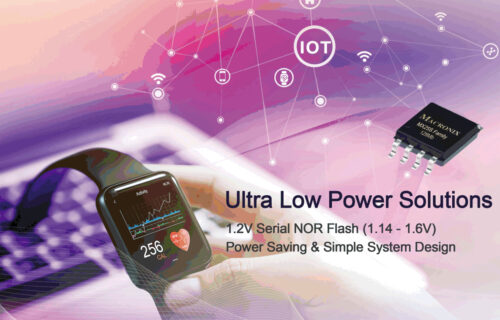By Omar Mohammed, Macronix America, Inc.
Giving design engineers a high- efficiency option.
Reducing overall power consumption in electronics systems is a genuine, ongoing concern among design engineers. And market demands reflect it: ultra-low-power (ULP) microcontroller units (MCUs), for example, are expected to represent 70% of the MCU market by 2027. The demand for ULP devices is also reflected in a broad range of markets, such as medical devices, wearables, industrial systems, and the IoT. These applications rely heavily on MCUs and flash memory, whose power efficiency can help ensure a design’s market success.
Balancing power efficiency and performance is a delicate undertaking—especially so in the medical-electronics market, where the wearable devices segment is expected to experience huge growth. This is due in no small part to the rise in remote care, an aging population around the world, and the medical field embracing new technology that makes healthcare more accessible globally. As such, healthcare is deploying electronic devices to aid in patients’ diagnoses and treatments.
Patient-wearable devices use an array of sensors to continuously read, monitor, and process data sets, and
to be able to transmit data to remote secure cloud storage facilities. Because of the extra components necessary to provide such functionality, along with the inherent restrictions of a wearable device, diligent care is necessary when designing these applications to draw as little power as possible, thereby maximizing overall battery life.
Healthcare isn’t the only market with an imperative to reduce power. In the industrial market, analysts predict IoT devices are expected to reach shipments of nearly 31 billion by 2025. No great surprise when you look at the burgeoning industrial- automation and smart- manufacturing segments.
So, we’ve established there’s a shift to lower power, if not ultra-low power. What does this mean for design engineers? Let’s start with power compatibility.
A design calling for a 1.2V MCU means other peripherals—such as flash devices, EEPROM, and RAM—need to adopt the same input voltage rail to reduce the design’s overall power consumption, increasing battery life in the process.
In other words, the design optimizes power efficiency when all the components’ input voltages match that of the MCU. Further, it being a low-voltage MCU, the benefits are not only battery power efficiency but also lower bill-of-material costs as well as simpler design complexity. This is because the design doesn’t require additional components like low-dropout regulators, voltage regulators, or other forms of boost circuitry, which themselves aren’t entirely efficient.
Design engineers, therefore, are increasingly looking at ULP flash memories, such as Macronix’s MX25S series. Its 1.2V (1.14V to 1.6V) for ULP consumption (0.8mA ICC active, 0.05μA ICC deep power down) addresses their low-power specifications, extending devices’ battery life (due to lower voltage operation and current consumption).
Again, flash memory and MCUs go hand-in-hand in emerging applications. The IoT is driving the need for microcontrollers to embrace ULP and, by extension, flash memory. Designs based on ULP flash and ULP MCUs not only reduce dynamic run power but also offer a variety of power modes. A sub-μA current consumption is possible in some implementations. These types of designs typically include power management integrated circuits (PMICs), memory, a battery, and other components that also benefit from power-saving improvements.
Summary
New designs using flash memory and MCUs are shifting steadily toward lower-power solutions as a key differentiator in countless industries. Medical devices, wearables, industrial systems, and the IoT are at the forefront of this shift,
as they enable smaller and more-mobile solutions. This is a great time to be developing ULP solutions like the MX25S, as well as an ideal time for engineers to design with them.

